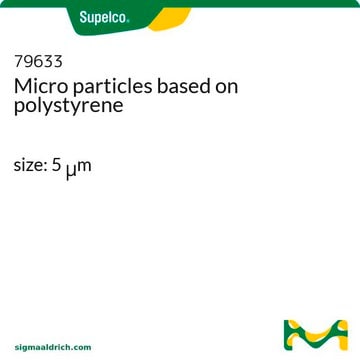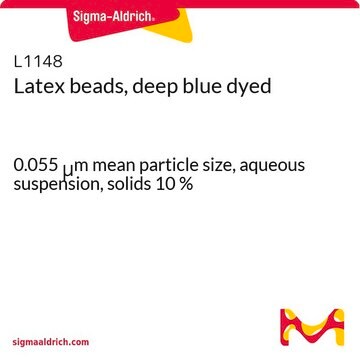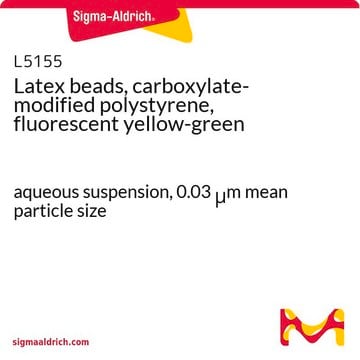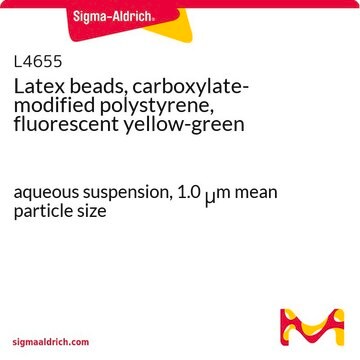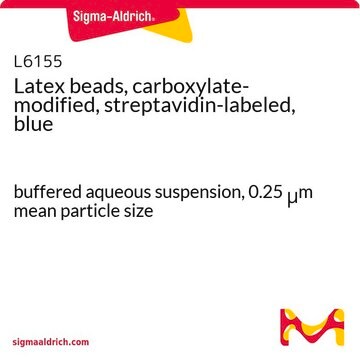LB8
Latex beads, polystyrene
0.8 μm mean particle size
Sinónimos:
Latex Beads, Latex Microspheres
Iniciar sesiónpara Ver la Fijación de precios por contrato y de la organización
About This Item
Productos recomendados
form
aqueous suspension
composition
Solids, 10%
packaging
pack of 1 mL
pack of 15 mL
pack of 2 mL
mean particle size
0.8 μm
¿Está buscando productos similares? Visita Guía de comparación de productos
General description
Polystyrene microparticles are stabilizedcolloidal particles that possess a negative charge and are synthesized by thepolymerization of styrene under conditions that induce spontaneous coalescentbead formation. Due to their versatility, these beads can be used in antibody-mediatedagglutination diagnostics, electron microscopy, cell counter calibration, andphagocytosis experiments.
Application
Polystyrene latex beads have been used:
- inthe flow cytometric assay of endothelial microparticles (EMPs)
- in thedetection of capsular polysaccharide (CPS) antibody/antigen latex agglutinationtest
- to evaluate the phagocytic activity in hemocytes of shrimps
Storage Class
12 - Non Combustible Liquids
wgk_germany
WGK 3
flash_point_f
Not applicable
flash_point_c
Not applicable
Certificados de análisis (COA)
Busque Certificados de análisis (COA) introduciendo el número de lote del producto. Los números de lote se encuentran en la etiqueta del producto después de las palabras «Lot» o «Batch»
¿Ya tiene este producto?
Encuentre la documentación para los productos que ha comprado recientemente en la Biblioteca de documentos.
Los clientes también vieron
Effects of traditional medical herbs ?minor bupleurum decoction? on the non-specific immune responses of white shrimp (Litopenaeus vannamei)
Yu-Sheng, et al.
Fish & Shellfish Immunology, 218-225, 84(1-842) (2017)
Humoral immune responses following experimental infection of goats with Mycoplasma capricolum subsp. capri pneumoniae
John B M, et al.
Veterinary Microbiology, 84(1-2) (2002)
AGE/RAGE-Induced EMP Release via the NOX-Derived ROS Pathway
Ying-Hua C, et al.
Journal of Diabetes Research (2018)
Je-Wen Liou et al.
PloS one, 6(5), e19982-e19982 (2011-05-19)
Recent research shows that visible-light responsive photocatalysts have potential usage in antimicrobial applications. However, the dynamic changes in the damage to photocatalyzed bacteria remain unclear. Facilitated by atomic force microscopy, this study analyzes the visible-light driven photocatalyst-mediated damage of Escherichia
Joanna Koziel et al.
PloS one, 4(4), e5210-e5210 (2009-04-22)
It is becoming increasingly apparent that Staphylococcus aureus are able to survive engulfment by macrophages, and that the intracellular environment of these host cells, which is essential to innate host defenses against invading microorganisms, may in fact provide a refuge
Nuestro equipo de científicos tiene experiencia en todas las áreas de investigación: Ciencias de la vida, Ciencia de los materiales, Síntesis química, Cromatografía, Analítica y muchas otras.
Póngase en contacto con el Servicio técnico

